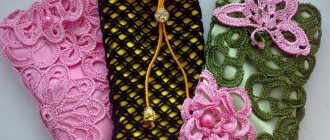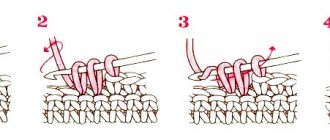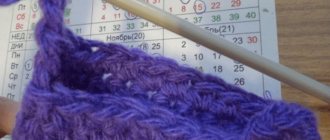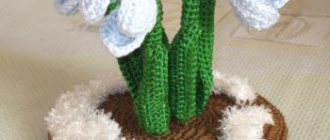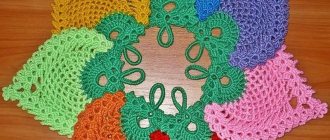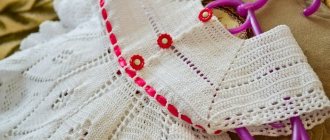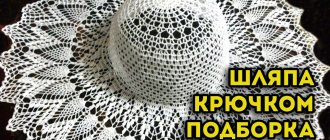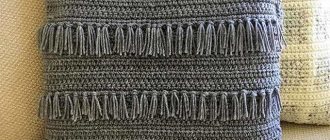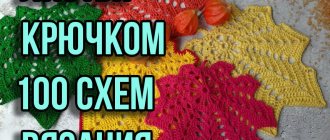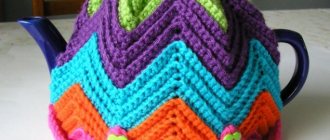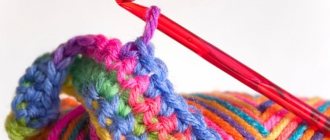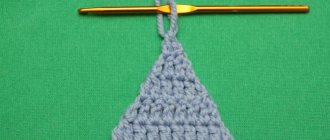Knitting booties for newborns, as a rule, attracts expectant mothers and grandmothers. Congratulations if you are one of them!
Even if you have never held a knitting tool in your hands before, today’s lesson will help you easily crochet booties for beginners with your own hands! Simple and original models with clear descriptions, videos, step-by-step instructions and photos will help you cope with this task perfectly!
Legend: p. – loop; V. n. - air loop; With. – column; With. without n. – single crochet; With. s n. – double crochet; p/s s n. – half double crochet; ss. – connecting column; R. - row.
The simplest crochet booties for your newborn. MK for beginners.
We will need:
- yarn (100% acrylic, 100 grams per 155 meters);
- cr. No. 5.
Size: from 1 month to 3 months.
Description
+ crochet 8 in. p.. 1 p.: 1 s. without n. in the 2nd paragraph from cr., 1 p. without n. in the next 5 p., 4 s. without n. in the last p., turn, knit along the chain in reverse order: 1 s. without n. in the next 7 stitches, connecting stitch in the 1st stitch of the row. 2 p.: 1 v. p., 2 p. without n. in the first 2 p., 1 s. without n. in the next 4 p., 2 p/s with n. in the next 5 p., 1 s. without n. in the next 4 p., 2 s. without n. in the last 2 p., connecting column in the 1st s. row. 3 p.: 1 v. p., 1 p. without n. in the next 10 p., 2 s. without n. in the next 6 p., 1 p. without n. in the next 10 p., ss in 1st s. row. 4 p.: 1 v. p., knit for the back segment of p. 1 s. without n. in each st., ss = 32 s.. 5 rubles: for both slices at once, 1 st. p., 1 p. without n. to the end, ss.. 6 p.: 1 v. p., 1 p. without n. in the next 10 p., (2 s. without n. knit together) x 6, 1 s. without n. in the next 10 p., ss.. 7 p.: 1 v. p., 1 p. without n. in the next 8 p., (2 s. without n. we knit together) x 5, 1 s. without n. in the next 8 p., ss.. 8 p.: 1 v. p., 1 p. without n. in the next 8 p., (2 s. without n. together) x 3, 1 s. without n. in next.. 7 p., ss.. 9 p.: 2 v. p., 1 s s n. to the end, ss. = 18 s. 10 rubles: 1 s. without n. in the first 8 p., 2 s. without n. in the next 3 p., 1 p. without n. in the next 7 p., ss.. 11 p.: ss. in every point..
We insert the ribbon into the holes between the posts and tie a bow. Simple crochet booties for beginners are ready!
Crochet sandals for boys. Step-by-step master class.
We will need:
- yarn of the 1st and 2nd colors (60% acrylic, 40% nylon, 140 grams per 420 meters) and 3rd color, for tying (65% acrylic, 35% wool, 100 grams per 151 meters);
- cr. No. 3.75 for size 3 months, No. 4 for 6 months. and No. 4.25 for 9 months..
Size: 3, 6, 9 months.
Master Class
First sole
Thread 1st color. dial 12 v. p.. 1 p.: 3 s. without n. in the 2nd paragraph from cr., 1 p. without n. in the next 6 p., 1 p/s with n. in the next 3 p., 7 p/s with n. to the last point of the chain, turn the work over, knit 1 p/s from the back side. in the next 3 p., 1 p. without n. in the next 6 p., 2 s. without n. in the last p., ss. = 30 p.. 2 r.: 1 v. p., 1 p. without n. in the 1st paragraph, 2 p. without n. in the 2nd paragraph, 1 p. without n. in the next 6 p., 1 p/s with n. in the next 4 p., 2 p/s with n. in the next 3 p., 3 p/s with n. in the next p., 2 p/s with n. in the next 3 p., 1 p/s with n. in the next 4 p., 1 p. without n. in the next 6 p., 2 s. s n. in the next p., 1 p. s n. in the 1st paragraph of this row, ss. = 41 p.. 3 r.: 2 v. p., 2 p/s with n. in the 1st p., 1 p/s with n. in the next p., 2 p/s. s n. in the next p., 1 p/s with n. in the next 14 p., 2 p/s with n. in the next 7 p., 1 p/s with n. in the next 14 p., 2 p/s with n. in the next p., 1 p/s with n. in the next p., 2 p/s with n. in the next p., ss. = 52 p..
The basis
We connect n. 2nd color in the 5th p. after ss., knit for the body p/s 3rd p. soles. 1 p.: 3 v. p., 2 p. s n. in the same paragraph, 1 p. s n. in the next p., 2 p. s n. in the next p., 3 c. p., pass. 5 p. soles, 2 p. s n. in the next p, 1 s. s n. in the next..p., 3rd century. p., skip 4 p., 2 s. s n. in the next p., 1 p. s n. in the next..p., 6th century. p., skip 12 p., 1 s. s n. in the next p., 2 p. s n. in the next p., 3 c. p., skip 4 p., 1 s. s n. in the next p., 2 p. s n. in the next p., 3 c. p., skip 5 p., 2 s. s n. in the next p., 1 p. s n. in the next p., 2 p. s n. in the next p., turn the knitting. 2 p.: 2 v. p., 1 p/s with n. in the next 15 p., 3 p. without n. Prov. vm. (2 s. over the last 2 s. of the previous row and 1 s. above the first p. of the arch of 6 v. p.), 4 p/s with n. in an arch, 3 pp. without n. vm. (last of 6 v.p. and 2 next s.), 1 p/s with n. in the next 15 p., 4 v. p., ss.. Left strap
Let's move on using ss. behind the inner wall in the 11th point on the right side. 3 r.: + 13 c. p. for strap, 1 p/s with n. in the 5th point from the cr. (= p. for button), 1 p/s with n. in the next 7 p. straps, 3 p. b n. vm. (remaining sts of strap and first 2 sts of base), 1 sts without n. in the next 20 sts (knit towards the heel, then end opposite the thread connection on the left side).
Right strap
Let's move on using ss. behind the inner wall in the 15th point on the left side. 3 r.: + 13 c. p. for the strap, 1 p/s with n. in the 5th point from the cr. (= p. for button), 1 p/s with n. in the next 7 p. straps, 3 p. without n. vm. (the remaining p. straps and the first 2 p/s of the base), 1 p/s without n. in the next 20 p..
Harness
Thread 3rd color. we tie the toes, heel, top and strap with. without n., prov. 3 s each without n. vm. in each corner and 5 s. without n. in paragraph for buttons.
Second sole
We dial 12 v. p.n. 2nd color.. 1-3 pp.: as 1-3 pp. first sole. 4 rubles: ss. in a circle through the canvas of the 1st and 2nd soles together. Sew on the button and the boy’s sandals are ready!
Original crocheted summer sandals for boys and girls. MK for beginners.
We will need:
- yarn (100% cotton, 100 grams per 155 meters) – 2 colors;
- cr. No. 5;
- 2 buttons.
Size: sandals are designed for a baby 3-6 (6-12) months.
Description (sandals for girls/boys 0-3 months)
Sole
We knit 2 pieces. color 1 and 2 pcs. color 2. 1st: 9th century. p., 3 p. without n. in the 2nd paragraph from cr., 1 p. without n. in the next 5 p., 1 p/s with n. in the next p. and 7 p/s with n. in the last p., turn the work over, continue on the other side of the chain, 1 p/s with n. in the next p., 1 p. without n. in the rest 5 p. = 22 p., do not connect, knit. in a spiral. 2 p.: 2 s. without n. in the 1st paragraph of the 1st row, 2 p. without n. in the next 2 p., 1 s. without n. in the next 7 p., 2 s. without n. in the next 5 p., 1 s. without n. in next 7 p. = 30 p.. 3 r.: (1 s. without n. in next p., 2 s. without n in next p.) x 3, 1 p. without n. in the next 7 p., (1 s. without n. in the next p., 2 s. without n. in the next p.) x 5, 1 p. without n. in the next 7 p., ss. = 38 p..
We connect two soles of different colors to each other using a s..
Track
We connect the thread of color. 1 at the end of the fingers (see photo 2), then according to the diagram. 1 p.: 1 v. p., 1 p. without n. in the next 27 sts, turn, leaving 11 sts unknitted = 27 sts. 2 rows: 1 st. p., 2 p. without n. together, 1 p. without n. in the next 11 p., 2 s. without n. vm., 1 s. without n. in the last 12 p. = 25 p., turn. 3 p.: 1 v. p., 2 p. without n. vm., 1 s. without n. in the next 10 p., 2 s. without n. vm., 1 s. without n. in the last 11 p. = 23 p., turn. 4 p.: 1 v. p., 1 p. without n. in the first 9 p., 1 p/s with n. in the next 5 p., 1 s. without n. in the last 9 p., turn = 23 p.. 5 p.: 1 in. p., 1 p. without n. in the first 3 p., knit. only for the right lobe, p. 1 ss. in the next 6 p., 1 p. without n. in the next 5 p., knit. only for the right lobe, p. 1 ss. in the next 6 p., 1 p. without n. in the last 3 p. = 23 p..
For the left bootie
We connect n. 2 from 1st r. bases of the stack on the left side (see photo 4), knitting. ss. up to the last river top of the foot, + 6 in. p. (button loop), ss. around the bootie until the 1st r. on the other side.
For the right bootie
As for the left one, only we make a hole for the button on the opposite side. Sew on the buttons.
Description (sandals for 6-12 months)
Sole
We knit 2 pieces. color 1 and 2 pcs. color 2. 1st: 10th century. p., 3 p. without n. in the 2nd paragraph from cr., 1 p. without n. in the next 5 p., 1 p/s with n. in the next 2 p. and 7 p/s with n. in the last p., turn over, continue on the other side of the chain, 1 p/s with n. in the next 2 p., 1 s. without n. in the last 5 p. = 24 p., do not connect. 2 p.: 2 p/s with n. in the 1st paragraph of the 1st row, 2 p/s with n. in the next 2 p., 1 p/s with n. in the next 8 p., 2 p/s with n. in the next 5 p., 1 p/s with n. in the next 8 p. = 32 p.. 3 p.: (1 s. without n. in the next p., 2 s. without n. in the next p.) x 3, 1 p. without n. in the next 8 p., (1 s. without n. in the next p., 2 s. without n. in the next p.) x 5, 1 p. without n. in the next 8 p., ss. = 40 p.. We connect two soles of different colors to each other using a ss..
Track
We connect the thread of color. 1 at the end of the fingers (see photo 2), then according to the diagram. 1 p.: 1 v. p., 1 p. without n. in the next 29 p., 11 p. not knitted. = 29 p.. 2 r.: 1 v. p., 2 p. without n. vm., 1 s. without n. in the next 12 p., 2 s. without n. vm., 1 s. without n. in 13 p. = 27 p.. 3 r.: 1 v. p., 2 p. without n. vm., 1 s. without n. in the next 11 p., 2 s. without n. vm., 1 s. without n. in 12 p. = 25 p.. 4 r.: 1 v. p., 1 p. without n. in each p. = 25 p.. 5 p.: 1 v. p., 1 p. without n. in the first 10 p., 1 p/s with n. in the next 5 p., 1 s. without n. in 10 p. = 25 p.. 6 p.: 1 v. p., 1 p. without n. in the lane 3 p., knit. only behind the front wall of paragraph 1 ss. in the next 7 p., 1 p. without n. in the next 5 p., knit. only behind the front wall of paragraph 1 ss. in the next 7 p., 1 p. without n. in the village 3 p. = 25 p..
For the left
Connection n. 2 in 1st row. base of the foot on the left side (see photo 4), ss. up to the village R. top of the foot, dial 6 v. p. (button hole), ss. around the slipper until the 1st r. on the other side.
For the right
As for the left one, only a hole for a button from 6 in. p. is done on the other side. Sew on buttons and booties for boys and girls are ready!
Beautiful and safe decor
Even the simplest crocheted booties can be made unique and original if you use bright decorative elements. But they must be as safe as possible in size and material of manufacture. The component must not cause injury to the baby. It is not allowed to use beads or buttons for the design, but multi-colored ribbons and sewn or knitted appliqués are acceptable.
Gluing decorative elements is prohibited, as a child can quickly tear them off and put them in his mouth. Everything needs to be secured with threads. Pins or rivets of any kind are not permitted. For boys, you can use appliques of the appropriate theme: marine, automobile, cartoon superheroes. The satin stitch embroidery looks interesting on the booties. Ornaments can be completely different. Only threads are used, beads cannot be used. For girls, flowers and hearts are suitable as designs, for boys - ethnic motifs.
Sequins, which are popular today, should not be used for embroidery, as their sharp corners and edges can scratch the baby’s skin.
Openwork slippers. MK.
We will need:
- yarn (100% cotton, 100 grams per 288 meters);
- cr. No. 2.
Size: for newborn.
Scheme
Trace - along the road. 1, toe - according to diagram. 2 and 4, heel – cx. 3.
Description
We knit a 12v chain. p., knit the foot according to c. 1. We tie the edge 4 r. With. without n. without increments and divide the number of stitches in half for the heel and toe.
We make 22 sts of heels 4 r. With. without n, then for the fastener we add an additional chain from c to one side. p. about 5 cm and tie it with. with n., leaving at the end a buttonhole for a button from 6 in. p.. According to cx. 2 we make a toe with a membrane and sew it to the insole. We do the second shoe in the same way.
Assembly
We thread the fasteners into the holes of the membranes and sew on the buttons.
Rainbow slippers. Master Class.
We will need:
- yarn (100% merino, 50 grams per 86 meters);
- cr. No. 2.5.
Description of the pattern
We dial 3 v. p., (pull out the thread from the 2nd p. from the edge, then from the 3rd, pull out the thread from the 1st p. p., pull out the thread from the back wall. from the next p. p. = 6 p. . on the edge, we knit all stitches in the middle) = first repeat, *(pull out 2 threads along the first repeat, 1 thread from the last knitted stitch of the previous repeat, 1 thread behind the back wall with the next 2 stitches = 6 p. on the edge, wire all p. vm.), repeat from *, ss..
This is shown more clearly in this video:
Required Tools
Having selected the yarn to crochet booties for a newborn, you also need to prepare the tool itself. Its length should not exceed 15 cm, otherwise it will be inconvenient for them to work. The size of the hook depends on the thickness of the selected thread:
- acrylic – 1.6;
- microfiber – 1.5-2.5;
- cotton – 1.5-2.
The thicker the yarn, the smaller the hook needed. In this case, the shape of the booties will be tight, and all bends and curves will be clear.
Additionally, the craftswoman may need tapestry needles for stitching parts and attaching decorative elements. Inexperienced knitters will find markers in the form of plastic rings useful - they can be used to mark rows.
Slippers-boots - description
Insole
+ 20th century p., in a ring. 1 p.: 1 p/s with n. in the 3rd paragraph from the cr., 1 p. s n. in the next 16 p., 4 p/s with n. in the last p., turn the work over, now continue on the other side of the chain, 1 s. s n. in the next 16 p., 1 p/s with n. in the last p., ss..
Change the color of the thread. 2 r. (only behind the back wall): 3 in. p., 1 p. s n. in the 1st paragraph, 2 p. s n. in the next 3 p., 1 p. s n. in the next 13 p., 2 p. s n. in the next 7 p., 1 p. s n. in the next 13 p., 2 p. s n. in the next 2 p., ss.
Change the color of the thread. 3 r. (only behind the back wall): ss. in the next p., 3 c. p., 2 p. s n. in the next 5 p., 1 s. s n. in the next 16 p., 2 p. s n. in the next 10 p., 1 s. s n. in the next 16 p., 2 p. s n. in the next 4 p., 1 p. s n. in the next p., ss. = 72 p..
Track
Change the color of the thread. We do 1 r. pattern = 36 repeats. 2 p.: 1 v. p., s. without n. (2 pp. for 1 repeat of the pattern of the previous row).
Replace n.. 1st row: with a pattern. 2 p.: 1 v. p., (2 s. without n. vm.) x 10, 1 s. without n. in next.. 36 p., (2 s. without n. vm.) x 8, ss. = 54 p..
Top
Change colors every row. 1 p.: 1 v. p., 1 p. without n. in the 1st paragraph, 1 p. without n. in the next 3 p., turn.. 2 p.: 1 in. p., ss. in the next With. piles, 2 p. without n. behind the rear Art. in the first p., 1 p. without n. for the back st. in each p., 2 p. without n. for the back st. in the last p., ss. in the next With. piles. 3 p.: 1 v. p., ss. in the next With. piles, 2 p. without n. for the front st. in the 1st paragraph, 1 p. without n. for the front st. in everything. p., 2 p. without n. for the front st. in the last paragraph, ss. in the next With. piles. Repeat 2-3 pp. until we get 11 s. in the r.. Connect without additions with. without n. until the 18th r..
For lace
3rd century p., prop. first 2 p., *1 s. s n. in the next p., 1st century p., prop. 1 p., repeat from *, 1 st. p., 1 p. s n. in the last p.. **Change color Sl. r.: pattern = 22 repeats. Sl. r.: 1 c. p., then connect with. without n. (2 pp. per 1 rap. pattern of the previous row), repeat. from ** more x 2.
Lace
Tie 40 in. p. in chain., 6 s. without n. in the 2nd paragraph from the cr.. Next 1 p. without n. in each p. (if you need a thin lace, make 1 dc in the remaining st.), 6 p. without n. in the last p., turn over and continue in the other direction, 1 s. without n. in each p., ss. Insert the lace and tie it into a bow.
What are pinettes
Booties are knitted shoes for babies (mainly under 1 year of age).
They may differ in:
- shape (boots, sandals, bast shoes, marshmallows, in the form of animals, etc.);
- knitting method (with seams, without seams, knitting from the top, from the trace, etc.);
- design (single-color and multi-colored, knitting pattern, lace, beads, etc.);
- seasonality (thick and warm, thin and light).
On the Internet you can find a huge number of photos of knitted booties; below is only a small part, demonstrating the variety of models and decor.
With all the breadth of choice, the main task of booties is to warm and protect the delicate baby skin, which is not suitable for wearing shoes.
Bright crochet booties and boots. Master class for beginners.
We will need:
- cotton yarn of medium thickness (choose the thickness according to the density of the knitting);
- cr. No. 3.5;
- 4 buttons.
Size: 0-3 (3-6, 6-9) months.
Description
Sole
Green thread dial 11 (12, 14) p.. 1 r. (green): 2 p/s. s n. in the 2nd p. from cr., 1 p/s from n. in the next 8 (9, 11) p., 6 p/s with n. in the village p., turn over, then along the other side of the chain, 1 p/s with n. in the next 8 (9, 11) p., 2 p/s with n. in the village p., ss. = 26 (28, 32) p.. 2 r. (green): 2 p/s with n. in the first 2 p., 1 s. without n. in the next 5 (6, p., 1 p/s with n. in the next 3 p., 2 p. with n. in the next 6 p., 3 p/s with n. in the next 3 p., 1 s without n. in row 5 (6,
dial 11 (12, 14) p.. 1 r. (green): 2 p/s. s n. in the 2nd p. from cr., 1 p/s from n. in the next 8 (9, 11) p., 6 p/s with n. in the village p., turn over, then along the other side of the chain, 1 p/s with n. in the next 8 (9, 11) p., 2 p/s with n. in the village p., ss. = 26 (28, 32) p.. 2 r. (green): 2 p/s with n. in the first 2 p., 1 s. without n. in the next 5 (6, p., 1 p/s with n. in the next 3 p., 2 p. with n. in the next 6 p., 3 p/s with n. in the next 3 p., 1 s without n. in row 5 (6, p., 2 s. without n. in village 2 p., ss. = 36 (38, 42) p.. 3 p. (green): 1 p. with n. in the lane 2 p., 2 p/s without n. in the next 3 p., 1 p/s with n. in the next 5 (6,
p., 2 s. without n. in village 2 p., ss. = 36 (38, 42) p.. 3 p. (green): 1 p. with n. in the lane 2 p., 2 p/s without n. in the next 3 p., 1 p/s with n. in the next 5 (6, p., 1 p. with n. in the next 3 p., (2 s. with n. in next p., 1 s. with n. in next p.) x 6, 1 s. with n. in next 3 p., 1 p/s with n. in the next line. 5 (6,
p., 1 p. with n. in the next 3 p., (2 s. with n. in next p., 1 s. with n. in next p.) x 6, 1 s. with n. in next 3 p., 1 p/s with n. in the next line. 5 (6, p., 2 p/s with n. in the village. 3 p., ss. = 48 (50, 54) p..
p., 2 p/s with n. in the village. 3 p., ss. = 48 (50, 54) p..
Stopochka
1 rub. - With. only behind the back wall of the loops. 4 rub. (green): 1 c. p., knit 1 s. without n. behind the back wall in each p., ss. = 48 (50, 54) p.. Attach a light green thread. 5 rub. (light green): 1 c. p., 1 p. without n. in each p., ss.. 6 rub. (light green): 1 c. p., 1 p. without n. in each p., ss. 7 rub. (light green): 1 c. p., 1 p. without n. in each p., ss.. 8 rub. (green): 1 c. p., 1 p. without n. in the first 14 (15, 17) p., (2 s. without n. vm., 1 s. without n. in the next p.) x 7, 1 s. without n. in the next 13 (14, 16) p., ss. = 41 (43, 47) p.. 9 r. (light green): 1 c. p., 1 p. without n. in the lane 13 (14, 16) p., (2 s. without n. vm., 1 s. without n. in the next p.) x 5, 1 s. without n. in the next 13 (14, 16) p., ss. = 36 (38, 42) p.. 10 r. (green): 1 c. p., 1 p. without n. in the first p., 2 p. without n. vm., 1 s. without n. in the next 9 (10, 12) p., (2 p/s with n.vm.) x 2, (2 p/s with n. vm.) x 2, (2 p/s with n. vm.) x 2, 1 p. without n. in the next 9 (10, 12) p., 2 p. without n. vm., 1 s. without n. in the next p., ss. = 28 (30, 34) p.. 11 r. (light green): 1 c. p., 1 p. without n. in the first p., 2 p. without n. vm., 1 s. without n. in the next 9 (10, 12) p., (2 s. with n. vm.) x 2. 1 s. s n. in the next 9 (10, 12) p., 2 p. s n. vm., 1 s. without n. in the next p., ss. = 24 (26, 30) p..
Cuff
Next, the boots (left, etc.) are knitted symmetrically. Let's move on using ss. 7 p. from the center of the front towards the heel. Turn the knitting so that the next R. it was necessary to tie towards the heel. 12 rub. (green): 1 c. p., 1 p. without n. in the next 23 (25, 29) p., emb. 6th century p. into the chain, turning.. 13 r. (green): 1 p/s with n. in the 3rd p. from cr., 1 p/s from n. in each p.r., turning. = 27 (29, 33) p.. 14 r. (light green): 2 c. p., 1 p/s with n. in the rest p., turning.. 15 rub. (green): 2 c. p., 1 p/s with n. in the rest p., turning.. 16 r. (light green): 2 c. p., 1 p/s with n. in all points, turning.. 17 r. (green): 2 c. p., 1 p/s with n. all the way, turn.. 18 rub. (light green): 2 c. p., 1 p/s with n. all the way, turn.. Green no. we tie the cuffs with. without n. and sew 2 buttons through two layers of cuff.
How to take measurements
Before you start knitting any model of indoor or outdoor shoes, you will need to take measurements. This is especially important if the products are created on a rigid base. Foot size in this case is a key indicator. To determine the exact parameters, you need to put on a sock and step on a ruler or measuring tape. You need to measure from the end of the heel to the top of the toe - the tip of the longest toe.
| Foot length, cm | Size (Russian) |
| 22,2 | 34 |
| 22,9 | 35 |
| 23,6 | 36 |
| 24,2 | 37 |
| 24,9 | 38 |
| 25,6 | 39 |
| 26,2 | 40 |
| 26,9 | 41 |
| 27,6 | 42 |
| 28,5 | 43 |
| 29,2 | 44 |
| 30 | 45 |
After determining the size, you need to measure the width of the foot at its narrowest and widest parts. These measurements are necessary to create smooth transitions from one half of the moccasins to the toe. You will also need to measure your foot at the ankle and determine the desired heel height of the future product. To ensure that the finished moccasins do not fit the foot too tightly, it is advisable to leave a small gap (about 4-5 mm) between the foot and the inner surface of the shoe.
Crochet sneakers booties Adidas. Master Class.
Original sneakers, varying the colors and emblems of which you can completely transform their appearance.
We will need:
- yarn of medium thickness, basic, white and black;
- cr. No. 4 and No. 3;
- awl No. 1.4;
- non-slip fabric for the insole.
Size: 1.5 years.
Scheme
Master Class
Adidas sneaker sole
Using crochet hook No. 4 and white thread, cast on 12 stitches. p., turn.. 1 r.: 1 v. p., ss. in the next 6 p., 1 p. without n. in the next 5 p., 3 s. without n. in the next p. (turn over the work and knit in the opposite direction), 1 p. without n. in the next 5 p., ss. in the next 6 p., connect in a circular row using ss. = 26 p.. 2 r.: 2 v. p., 1 p. without n. in ss., 2 p. without n. in the next p., 1 p. without n. in the next 10 p., 2 s. without n. in the next 3 p., 1 p. without n. in the next 10 p., 2 s. without n. in the next p., ss. = 32 p. 3 r.: 2 v. p., 1 p. without n. in the next p., 2 p. without n. in the next 2 p., 1 s. without n. in the next 8 p., 1 p/s with n. in the next 2 p., 2 p/s with n. in the next 2 p., 1 s. s n. in the next 2 p., 2 p/s with n. in the next 2 p., 1 p/s with n. in the next 2 p., 1 s. without n. in the next 8 p., 2 s. without n. in the next 2 p. = 40 p.. 4 p.: 2 v. p., 1 p. without n. in the next p., 2 p. without n. in the next 3 p., 1 p. without n. in the next 12 p., 2 s. without n. in the next 3 p., 1 p. without n. in the next 2 p., 2 s. without n. in the next 3 p., 1 p. without n. in the next 12 p., 2 s. without n. in the next 3 sts, turned around, do not cut n. = 52 p..
Insole
We cut out the insole in the shape of the sole from the fabric, place it on the sole and connect it. them with. without n. using an awl. 4 p.: 2 v. p., 2 p. without n. in the next 3 p., 1 p. without n. in the next 12 p., 2 s. without n. in the next 3 p., 1 p. without n. in the next 2 p., 2 s. without n. in the next 3 p., 1 p. without n. in the next 12 p., 2 s. without n. in the next 3 p., 1 p. without n. in the next p, ss. = 52 p..
Leg
We use cr. No. 3, we make 5 and 7 pp. behind the back wall.. 5 p.: 2 v. p., 1 p. without n. in each p., ss. = 52 p.. 6 r.: 2 v. p., 1 p. without n. in each p. (for both slices of p.) = 52 p.. 7 r.: 2 v. p., 1 p. without n. in each p., ss. = 52 p..
Contrast line
It can be done in three ways: nit. basic or black, crochet number 3 or needle, conn. counter. n. in the center of the back. 1) from LAN prov. ss. through the panel of the 7th row.. 2) with IS wire. ss. through the panel of the 7th row.. 3) embroider with a needle using a “back needle” seam.
Fingers
Mark the center with a pin. p. sides of the fingers, count 7 p. in both directions, put 2 more pins = 13 p. between them. Connection n. white in place of the outer pin, knit 1 r: 2 v. p., (2 s. with n. vm.) x 2, 3 s. s n. vm., (2 s. with n. vm.) x 3, turn.. 2 r.: 2 in. p., 6 p. s n. vm.. Cut off the n., stretch it through the village. 6 p., pull tight and fasten.
Sneaker tongue
With LS cr. No. 3 and no. basic color knitting 9 p. without n. along the line of the fingers, 1 in. p., turning.. 2 r. (IS): 1 s. without n. in p. of revolution, 1 s. without n. in the next 8 p., 1 v. p., turning. = 10 p.. 3 r. (LS): 1 s. without n. in p. of revolution, 1 s. without n. in the next 9 p., 1 v. p., turning. = 11 p.. 4 p.: 1 s. without n. in the next 10 p., 1 v. p., turning. = 11 p.. 5 p.: 1 s. without n. in the next 10 p., 1 v. p., turning. = 11 p.. 6 p.: 1 s. without n. in p. of revolution, 1 s. without n. in the next 10 p., 1 v. p., turning. = 12 p.. 7 p.: 1 s. without n. in p. of revolution, 1 s. without n. in the next 11 p., 1 v. p., turning. = 13 p.. 8 p.: 1 s. without n. in the next 12 p., turning. = 13 p.. 9 p.: ss. in the first paragraph, 1 p. without n. in the next 2 p., 1 p/s with n. in the next 2 p., 1 s. s n. in the next 3 p., 1 p/s with n. in the next 2 p., 1 s. without n. in the next 2 p., ss. to the end row = 13 sts..
The basis
Connected with LAN n. main color to the loops of the fingers 2 stitches before the left pin. 1 p.: tie ss. behind the rear a slice along the last river. feet (white) to the pin on the 2nd side. + 2 p., 1 v. n, turning. = 41 sts. Place a mark between the 2 central sts on the heel. 2 r. (IS): prop. n. turn, 2 s. without n. vm., knit 1 s. without n. in each p. to the mark, 2 s.. without n. vm., 1 s. without n. in all paragraphs to last. 2 p., 2 s. without n. vm., 1st century p., p. = 38 p.. 3 r. (LS): skip the turn point, 2 s. without n. vm., 1 s. without n. in p. to the mark, 2 s. without n. vm., 1 s. without n. up to 2 p., 2 s. without n. vm., 1st century p., p. = 35 p.. 4 p.: skip the turn p., 2 s. without n. vm., 1 s. without n. to the mark, 2 s. without n. vm., 1 s. without n. in up to 2 p., 2 s. without n. vm., 1st century p, p.v. = 32 p..
Now the decreases are only for the fingers. 5 p.: skip the turn point, 2 s. without n. vm., 1 s. without n. up to 2 p., 2 s. without n. vm., 1st century p, p.v. = 30 p.. 6 p.: skip the turn p., 2 s. without n. vm., 1 s. without n. up to 2 p., 2 s. without n. vm., 1st century p, p.v. = 28 p.. 7 p.: prop. n. turn, 2 s. without n. vm., 1 s. without n. up to 2 p., 2 s. without n. vm., 1st century p, p.v. = 26 p.. 8 p.: prop. n. turn, 2 s. without n. vm., 1 s. without n. up to 2 p., 2 s. without n. vm., 1st century p, p.v. = 24 p.. 7 p.: prop. n. turn, 2 s. without n. vm., 1 s. without n. up to 2 p., 2 s. without n. vm., 1st century p, p.v. = 22 p..
Rep. counter.. line along the base on the collision of the base. and white (ONLY if you did not finish the previous control line along the fingers).
Lace
Kr. No. 3 tight emb. chain of 70 v. p., ss. in lev. lower corner from the fingers (connection to the base - green), 7 in. p, ss. in the lower corner ave., emb. 70th century p, cut n.. Tie the lace using the holes between the rows.
Emblem
Kr. No. 3 emb. 1st century p.. Sl. r.: 2 c. p., 9 p/s with n. in p., ss., cut off n. Black we sew the star onto the emblem and sew it on. Fashionable Adidas sneakers are ready!
Knitted sandals
For light sandals, you should choose thin yarn made from natural fibers (cotton, linen) or microfiber. For such shoes, the sole should be knitted with almost no increase in size, since the light open bootie has an exact fit on the leg. The peculiarity of sandals is that the instep is not knitted with a closed fabric . The sole and heel are knitted separately.
Having finished knitting the backdrop at the desired height, do not break the thread. Starting from the corner of the backdrop, a chain of air loops is assembled for one strap. To knit a strap in the opposite direction, first make a loop at the end for the button, and then use single crochets to go back along this chain.
Without tearing off the thread, knit a row of stitches along the back to the second side and knit the second strap in the same way. The thickness of the strap should be knitted in straight and reverse rows. You can sew a button on it without a loop. The sock is usually knitted in the form of an arc or a figured element of a suitable size.
Children's slippers. MK.
We will need:
- medium thickness yarn, 20 grams of main color. and 5 grams of additional color.
- cr. No. 3.5.
Size: for feet 14-16 cm.
Scheme
Master Class
sole
Nab. 19th century p., + 3 c. lifting point, then according to the diagram. 1 rub. diagrams: 3 s. s n. in the first paragraph, 1 p. s n. x 17.7 s. s n. in the last p., flip. work, 1 p. s n. x 17, 3 s. s n. in the last p., ss.. 2 p.: 3 v. p., 1 p. sn., 2 s. s n. x 3.1 s. s n. x 17, 2 p. s n. x 7, 1 s. s n. x 17, 2 p. s n. x 3, ss.. 3 p.: 3 v. p., 1 p. sn., 2 s. s n. x 3.1 s. s n. x 20, 2 s. s n. x 14, 1 s. s n. x 20, 2 s. s n. x 3, ss..
Top
Motive according to the scheme.
Stopochka
1 p.: 3 v. p., 1 p. s n. for the ass Art. in each p., ss.. 2 p.: 4 v. p., 1 p. with n., * skip 2 p.r., (1 s. with n., 1 v. p., 1 s. with n.) in the next. p., repeat from *. 3 p.: 4 v. p, 1 s. without n., (1 s. without n., 2 v. p., 1 s. without n.) in each arch. Connection motive, as shown in diagram.. 4 p.: 4 c. p., 1 p. with n., (1 s. with n., 1 v. p., 1 s. with n.) in the arch x 7, * 1 s. without n. in motive, 2nd century. p., repeat from * along the width of the motif, (1 s.n., 1 v.p., 1 s.n.) in the arch to the end of the r..
Harness
Let's move to n. contrasting color, tie it around the edge with. without n. and 3rd century. P..
Knitting stages
Moccasins consist of a base, back (heel), side parts, and a toe. The product can be made in two ways: seamlessly knitted or by sewing together individual elements made in accordance with pre-prepared patterns. When creating one-piece moccasins, the insole base is first made. Afterwards, loops are collected along its edge, from which the side parts are formed.
Based on the existing patterns, you can crochet women's moccasins with felt, leather or polyurethane soles. When sewing individual parts, it is recommended to use either a contrasting thread and a crab stitch, or yarn to match the main color of the product and a needle with a wide eye. An experienced craftswoman just needs to look at a thing that will serve as a sample for work, and she will immediately make the necessary calculations and patterns without any problems, and select the optimal patterns for knitting. Less skilled knitters are encouraged to complete the job using the moccasin crochet tutorial below.
Base
For the insole you will need to cast on 10 single crochets using a single thread of medium thickness. When using finer yarn, more stitches are needed. After knitting 2-3 rows, attach the fabric to the pattern and make sure that it exactly follows its contours. During the work process, it is necessary to constantly monitor the knitting for compliance with the patterns.
Then in rows 2, 3 and 4 you need to knit 1 loop on each side, knitting single crochets. Next, make 16 cm and add 2 more loops in each row. Then you can start decreasing 2 stitches in each row until 5 stitches remain. The base is ready.
If the sole of unnecessary shoes is used for work, it must be separated in advance, being careful not to damage it. After this, you need to heat the awl and, using it, make holes along the upper edge of the product. Next, the sole needs to be tied.
Crochet children's moccasins are made based on the same patterns. The main thing is to make the necessary measurements correctly.
Cast on 10 single crochets
Knit 2-3 rows, attach the fabric to the pattern
In rows 2, 3 and 4, knit 1 loop on each side
Make 16 cm, add 2 loops in each row
Decrease 2 stitches on each row until 5 stitches remain
Tie the sole with another thread
Top part
The manufacture of a separate part of the upper part is not required for all models, for example, if the future moccasin slippers do not require laces. If you use knitting needles, you will need to adjust the number of stitches so that the fabric matches the pattern. To crochet other patterns, you can use the master class below:
- Cast on 12 stitches and knit 5 rows with a single crochet.
- In the 4th row you should make several holes for the laces. To do this, every 3 sc you need to perform 1 air loop.
- For each pair you will need 2 parts - right and left.
- Each piece is tied around the edge in single crochets with a thread of the main color - this will help make them beautiful and perfectly even.
The holes for the laces should not be too large or small. Their size will depend on the thickness of the yarn. When using very thin threads, 2 air loops may be required to create them. If you knit moccasins with knitting needles, the hole for the laces should be made using only one yarn over.
Knit a side of the required height
Make holes for laces
Tie the edges with a thread of a different color
Backdrop
The heel is a rectangular part, which should have greater density compared to other parts of the sneakers. This is necessary for more comfortable putting on and wearing shoes. To give the detail density, you will need to add another thread of the main color to the knitting or take a thinner hook. To make a backdrop, you need to knit a rectangular strip 21 cm long and 5-6 cm wide (depending on the desired height of the product). Then you should tie the resulting part around the edges with single crochets.
Knit the required number of rows for the sides
Cape
Cast on 34 loops and knit the fabric in single crochets, decreasing 2 loops on each side every other row. Knitting must be continued until 5 loops remain. These patterns are also suitable for making shoes with knitting needles. For men, it is recommended to make the cape using half-stitch stitches or regular stockinette stitch. Knitted or crocheted men's moccasins should not look too dressy, while for women or children, the toe can be made in the form of an openwork floral motif.
Cast on stitches to form first row
Second row
Continue knitting to the required cape size
Decoration
You can decorate women's slippers using a lace, threading it through the holes of the knitted fabric in the heel area. Also, the finished product can be decorated with beads, rhinestones, knitted floral motifs or appliqués. Women's models look great with sequins, from which you can embroider any pattern or design you like.
To decorate men's shoes, you can use decor in the form of a large button or metal rivets, appliqués with inscriptions, or images of a soccer ball. However, most men prefer to wear plain moccasins without any bright details or embellishments.
To decorate shoes for small children, it is better to use a finish that will attract the attention of the baby. These can be crocheted appliques in the form of animal figures, flowers, leaves. For girls, lace, bright beads, satin roses, and bows are suitable as decoration. Crochet items for boys will look great with pom-poms, colored inserts made from yarn in contrasting shades, a funny face and ears of a cartoon character.
If you use a thread of a different color to connect the parts, the seams will serve a decorative function. Below is a master class on assembling parts of crocheted moccasin slippers. Such a seam will decorate home models or indoor baby booties especially effectively.
To connect the parts you need:
- Place them right side up and bring together the edges that need to be sewn.
- Insert the hook into the outer loop of one piece, and then into the outer loop of the second.
- Knit a single crochet.
- Pass the hook through the second loops of both pieces and single crochet again.
- Repeat joining the edges of the workpieces in the same way, knitting each knitting loop.
- It is recommended to use a long enough thread for the work so that it is enough to connect the entire seam, and you do not have to make knots in the most inappropriate places.
After assembling the parts, the resulting workpiece should be sewn to the base and the edges should be tied.
Booties shoes for girls. MK.
We will need:
- yarn (100% bamboo fiber, 50 grams per 137 meters) – 1 skein of white and 1 skein of black;
- cr. No. 3.25 mm.
Size: 6-12 months.
Description
Cuff booties shoes (x 2)
White thread emb. 18th century p.. 1 r. (PM): 1 p/s with n. in the 2nd p. from cr., 1 p/s from n. in all sts = 17 sts.. 2 p.: 2 in. p., p/s s n. behind the rear Art. p. to end.. Rep. 2nd r. up to a height of 4 cm, order wrong side, do not turn. work, dial 13 in. n, turn it around.
Top part
1 p.: p/s with n. in the 2nd p. from cr., 1 p/s without n., 1 p/s with n. for the back st. p. in each p. p., wrap = 29 p.. 2 p.: 2 in. p., 1 p/s with n. behind the back wall of the stitch in the first 17 stitches, 1 p/s. from n (for both walls) to the end of the r., wrap it around. 3 p.: 2 v. p., 1 p/s with n. in 12 p., 1 p/s with n. behind the back wall p. to the end. r.. Alternate 2-3 r. until the top of the sock is 5 cm wide.
Continuation cuff
Sl..r.: 2 c. p., 1 p/s with n. for z. wall st in 17 sts, wrap. We do this again and again until the height is 5 cm, ending on the right. We unite the river. With. without n. dialed edge cuff, n. We don’t cut it off.
End
1st century n., knit 11 s. without n. along the bottom side cuff to the top of the feet, 12 s. without n. on the side, mark in the last s., 13 s. without n. along the front of the top of the feet, mark in the first p. from the words set s., 12 s. without n. on the second side of the top of the feet, and 12 s. without n. on the underside of the cuff.
Booties shoes (make 2)
Black n. + 15th century p.. 1 circular r.: 1 p/s with n. in the second paragraph from cr., 1 p/s from n. in the next 12 p. 5 p. without n. in the village p. chain, turn over, 1 p/s with n. in the next 12 p. and 2 s. without n. in the first n. chain., ss. = 33 p.. 2 r.: 2 v. p., 2 p/s with n. in connection point, 2 p/s with n. in the next p., 1 p/s. s n. in the next 12 p, (2 p/s with n. in next p.) x 5, 1 p/s with n. in the next 12 p., (2 p/s with n. in next p.) x 2, ss. = 42 p.. 3 r.: 2 v. p., 2 p/s with n. in p. connect., (2 p/s with n. in next p.) x 2, 1 p/s with n. in the next 16 p., (2 p/s with n. in next p.) x 6, 1 p/s with n. in the next 16 p., (2 p/s with n. in next p.) x 2, ss. = 54 p.. 4 r.: 2 v. p., 1 p/s without n. in p. connection, 1 p/s with n. in the next 25 p., (2 p/s with n. in next p.) x 6, 1 p/s with n. in the next 22 p., ss., wrap = 60 p.. 5 p.: 2 in. p., p/s s n. for z. wall p. in 26 p., mark, 1 p. s n. in the next 15 p., mark, 1 p/s with n. in the next 19 p., wrapped...
Strap (x 2)
Black n. + 21st century p. Then 1 p/s with n. in the second paragraph from cr., 1 p/s from n. in all p..
Assembly
Black n. sew and sew the sock to the shoe (we place the bootie fabric of the shoe over the sock fabric, sew the sock section through both walls, and the shoe section only through the back. p.). We tie the edges of the shoe with. without n. per lane arch p., sew on the straps.
Knitting booties is simple and fun! You can read about how to knit booties with knitting needles in this article. We hope our master class today gave you some ideas for children's shoes.
Buckle selection
When knitting booties for children, you need to choose materials wisely. Key points to note:
Yarn composition
- Natural wool is strictly contraindicated for small children, since animal hair can serve as an impetus for the development of an allergic reaction in the baby. In addition, small villi, not noticeable on the rougher skin of an adult, can cause discomfort to a small child, causing a prickly sensation and itching. Woolen items can become deformed and shrink if not washed correctly.
- Synthetics - in their pure form, can also cause an allergic reaction, since they do not have the necessary hygroscopicity and also impede air circulation. At the same time, it has excellent external qualities and does not deform when washed.
- Cotton is a hypoallergenic, environmentally friendly material, the disadvantages of which include the lack of elasticity. Cotton does not have a warming effect, so in its pure form it is mainly used for knitting summer items.
The ideal option for knitting children's clothes, including booties, is a balanced combination of all the materials listed above. For this purpose, almost all manufacturers offer special yarn for children, for example, “Krokha”, “Kid”, “Baby”, “Fidget” and others.
Dyes
Products for children, of course, should please the eye with bright and rich colors. But caring for a child requires special attention to the chemical properties of dyes - a bright, beautiful color is not always an indicator of the high-quality color of the threads.
Note!
How to knit sleeves with knitting needles: photos of stylish styles, instructions, diagrams, patterns for beginners
Knitted overalls for newborns (130 photos) - DIY knitting methods + detailed patterns for beginners
How to knit a shirtfront with knitting needles: TOP-110 photos + master class for beginners, simple patterns with detailed descriptions
Yarn that fades when washed is strictly contraindicated for knitting children's clothes, since this means that the chemical compounds used to dye it will settle on the child's skin and penetrate his body.
Experienced craftswomen first check the yarn for dye fastness. To do this, you need to knit a small sample, wash it in hot (!) water and wrap it in a piece of white cotton fabric. If the fabric remains without traces of dyes, the yarn can be used for knitting children's products without fear.
A sharp unpleasant odor from the yarn should also alert the knitter.
